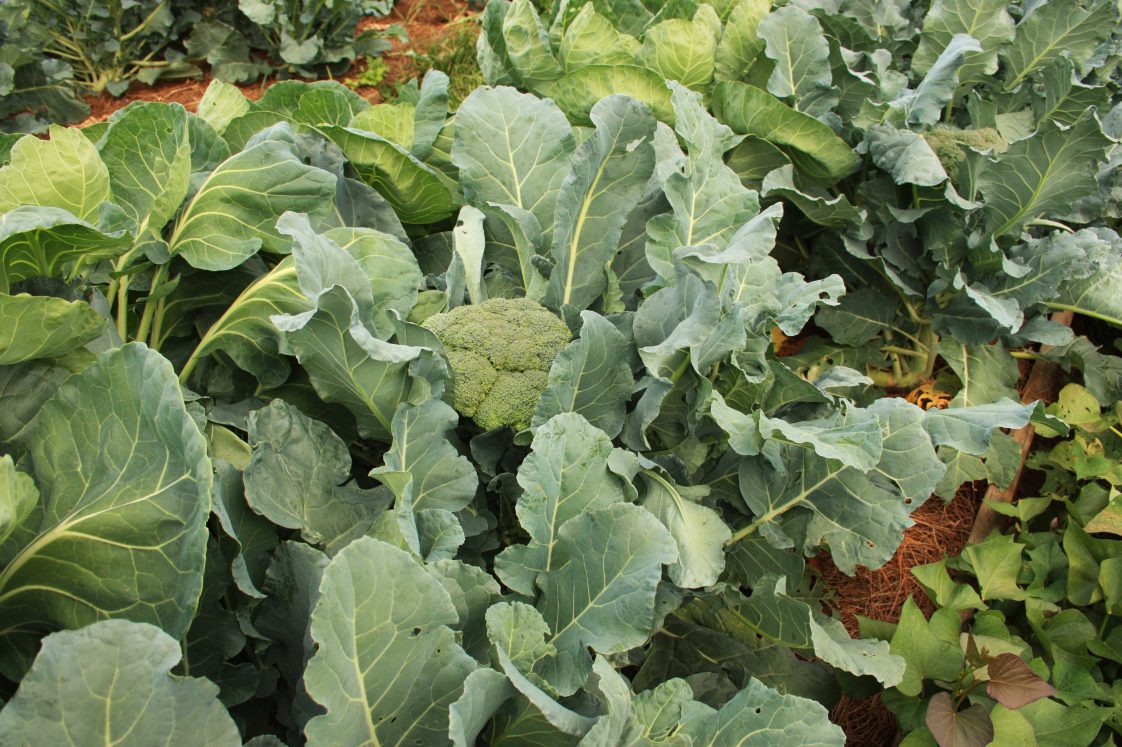Crop Production

As the fall broccoli season approaches, growers should be prepared for the challenges of crop production during the growing season. Weather conditions are conducive to various insects and diseases that can significantly impact crop development and yield of broccoli. To ensure optimal production and profitability, growers should implement strategies that effectively address pest pressures.
Integrated Pest Management (IPM) is a comprehensive approach to manage pests in agriculture. This report provides Alabama’s growers with practical insights into implementing IPM practices for broccoli production that can help mitigate the impact of common pests during the fall growing season. By integrating cultural, biological, physical, and chemical control measures, growers can optimize their yields while minimizing the use of synthetic pesticides. Below, there are several insects and diseases that commonly impact fall broccoli crops in the southeastern United States.
Insects of Fall Broccoli
- Cabbage Worms (Pieris spp.): These caterpillars feed voraciously on broccoli foliage, leading to reduced photosynthesis and stunted growth.
- Aphids (Various species): Aphids drain nutrients from plants and can transmit viruses, leading to reduced quality and yield.
- Diamondback Moth (Plutella xylostella): Larvae of this moth cause extensive damage by feeding on the leaves, leading to the characteristic “shot-hole” appearance.
- Armyworms (Spodoptera spp.): These voracious caterpillars feed on leaves and can cause rapid defoliation if not managed effectively.
- Flea Beetles (Phyllotreta spp.): These small beetles feed on foliage, creating tiny holes that can stunt plant growth and reduce marketable yield.
Diseases of Fall Broccoli
- Black Rot (Xanthomonas campestris pv. campestris): Caused by a bacterial pathogen, black rot affects both leaves and heads, causing dark, V-shaped lesions.
- Fusarium Wilt (Fusarium spp.): This fungal disease attacks the vascular system, leading to wilting and stunted growth.
- Alternaria Leaf Spot (Alternaria spp.): Characterized by circular lesions on leaves, this fungal disease can reduce photosynthesis efficiency and overall plant vigor.
- Downy Mildew (Hyaloperonospora parasitica): This fungal disease affects leaves, causing yellowing and a downy appearance on the underside.
- Clubroot (Plasmodiophora brassicae): A soil-borne disease, clubroot causes the roots to develop abnormal growths, impeding water and nutrient uptake.
Pest and diseases infestations present significant challenges to fall broccoli production, resulting in considerable yield reduction and substantial economic losses. Therefore, implementing integrated pest management (IPM) strategies is highly recommended, which involves a combination of preventive measures, monitoring, and targeted interventions.
IPM Practices to Avoid Fall Broccoli Pests
Cultural Practices
- Cultivar selection: This is the first step of an IPM plan. Cultivars should be selected according to weather conditions and resistance to potential pests reported for the growing region.
- Crop rotation: Avoid planting broccoli in the same field for consecutive seasons, this will disrupt pest life cycles.
- Clean cultivation or sanitation: Remove crop residues promptly to eliminate potential pest habitats and manage weeds within and around the broccoli field.
- Optimal planting time: Aim for early planting to minimize pest exposure during vulnerable growth stages.
Biological Control
- Encourage natural enemies: Release beneficial insects like parasitic wasps and ladybugs to control aphid and caterpillar populations.
- Bacillus thuringiensis (Bt): Use of Bt formulations to specifically target caterpillar pests without harming beneficial insects.
Physical Measures
- Row covers: Use lightweight row covers to physically exclude pests from the crop during vulnerable stages.
- Traps: Set up pheromone traps to monitor moth activity and make informed management decisions.
- Mulching: Apply organic mulch around plants to deter soil-borne pests and create an unfavorable environment for weeds.
Chemical Control
- Selective insecticides: Choose insecticides that target specific pests while sparing beneficial insects.
- Threshold-based spraying: Monitor pest populations and spray only when pest numbers exceed established thresholds.
- Rotating pesticides: Rotate the use of different classes of pesticides to reduce the risk of developing pest resistance.
- Follow label instructions: Adhere to recommended application rates and timings to avoid resistance development.
Regular monitoring (scouting) of fields, proper identification of pests, and timely interventions are key to achieving optimal yields and maintaining the health of the broccoli crop. Food safety practices are also important for broccoli production since it can be contaminated with foodborne pathogens. The use of good agricultural practices on the farm, including constant monitoring of irrigation water quality, the use of properly composted manure, prevention of animal intrusion in the fields, as well as proper harvesting and post-harvesting practices can help to avoid broccoli contamination. For more information about food safety training, visit: https://www.fda.gov/food/food-safety-modernization-act-fsma/fsma-final-rule-produce-safety

